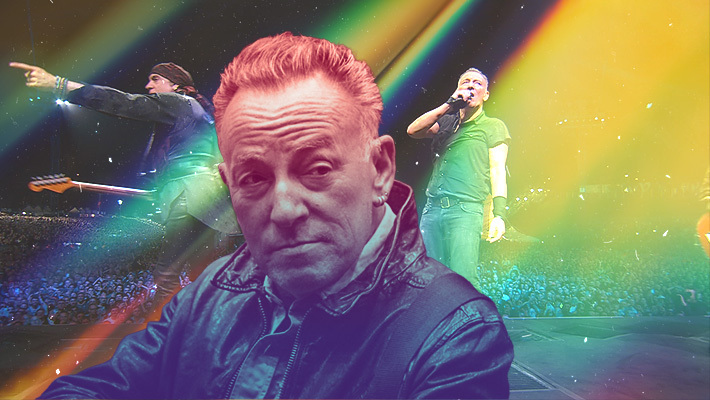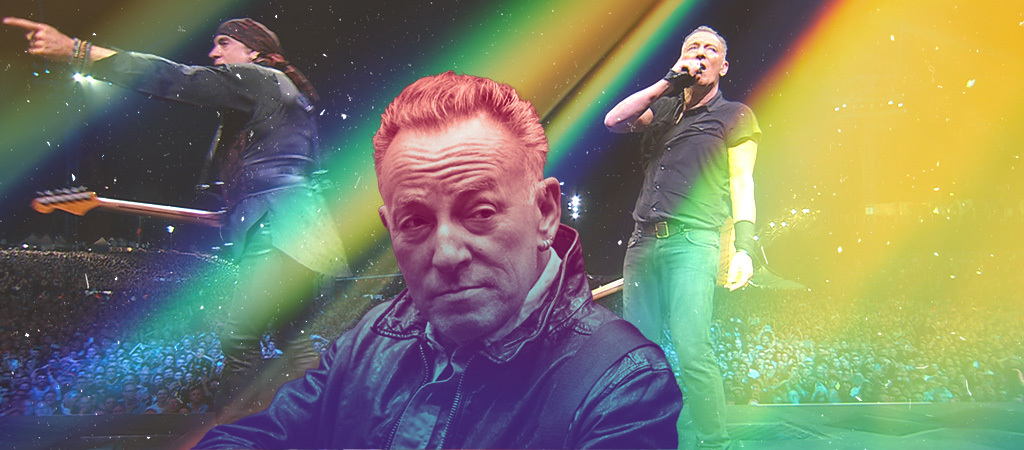
When Thom Zimny was growing up in New Jersey, he would his ride bike down to the local boardwalk and listen to Bruce Springsteen. This is not an exceptional biographical detail for a guy who grew up near Asbury Park. What is exceptional is that Zimny went on to make scores of films about The Boss, with The Boss.
It started with Live In New York City, the 2001 concert film covering Springsteen’s reunion tour with The E Street Band, which Zimny edited while also working on television shows like The Wire. Four years later, he was asked to direct Wings For Wheels, a documentary about the making of Born To Run, which netted Zimny a Grammy. From there, he became Bruce’s de-facto in-house filmmaker. He went on to direct retrospective docs like The Promise: The Making Of Darkness On The Edge Of Town along with contemporary documents such as Springsteen On Broadway (which won Zimny an Emmy) and Bruce Springsteen’s Letter To You, about the recording of the 2020 album.
After breaking in with Springsteen, Zimny went on to make films about Elvis Presley, Sylvester Stallone, and The Beach Boys. But Bruce remains his principal focus. Zimny’s latest work is Road Diary: Bruce Springsteen & The E Street Band (debuts Friday on Hulu), which follows Bruce on his recent world tour, the first for The E Street Band in six years. Zimny was initially invited to shoot rehearsals, where he watched the aging powerhouse band shaking off some rust as they worked themselves into peak fighting shape. He also observed Springsteen carefully compiling his setlist, which juxtaposed songs from his past and present to underscore an overarching narrative about the passage of time. This element was clear to me when I saw the tour in 2023, and the film confirms how mindful Springsteen was about embedding themes of mortality and familial resilience as the tour unfolded in America and Europe. Ultimately, Road Diary is a tribute to Springsteen’s connection with his stalwart band, and with the audience that welcomed him back after the pandemic shutdown.
Working with Springsteen — and having access to his vaults, which Zimny says still has lots of footage the public has never seen — would be a dream for any fan. But how exactly does Zimny’s relationship with Bruce and his operation work? I wanted to find out, so I chatted with the filmmaker over Zoom.
When you make these films, how much independence do you have? Are you determining the vision, or is that a collaboration with Springsteen and his manager Jon Landau?
The collaboration in the filmmaking process on all these, especially Road Diary, comes from this place of starting with a simple idea, which is, “you will go to the rehearsals, you’ll film the band, let’s see what we get.” That’s the start of the collaborative process. There’s not a set POV, there’s not a treatment written, there’s none of the familiar film things. It’s more like, let’s see what the footage is telling us, let’s see what stories are there. And I’m given a lot of freedom to be that fly on the wall, because in the past 24 years, there’s a lot of trust that’s been developed. And that’s a priceless thing as a filmmaker because you get access.
After a little bit of time, I put some scenes together and call Jon and Bruce and say, “I see things here.” And they’ll see details that I’m not seeing and the conversation starts and then it keeps building. But we never set out with a determined POV. I always let the film talk to me. And one of the first things I saw was that this was an E Street Band film. I got a lot of time with them to not only unpack the rehearsals, which ended up in Road Diary, but to dig into some E Street lore.
You ended up following the band on tour, but this isn’t a concert film. Was there as a moment when you realized this was going to be more of a “behind the scenes” documentary?
In the rehearsals, I observed him building a set and I knew right away that that was a detail that was emotionally interesting to me. And I knew from the very first show when I saw him play an older song, “Backstreets.”, against a new song, “Last Man Standing, that something magical happened not only to the audience, but for me as a filmmaker. And then I started to chase that. I wanted to explain it in the film, which is Bruce created a story with old and new songs. He created a story that an audience was connecting to, especially after being shut down for years. I was an emotional journey that had all these different themes, all these different arcs. So, there’s humor in the film, there’s reflection, there’s sadness. These are the things I was picking up from the live show and, if anything, the live show was cluing me into how I wanted the edit to feel.
You’ve worked on a mix of archival projects and “in the moment” movies where you’re documenting whatever it is Bruce is doing at the time. Are you basically filming everything he does at this point? Are there tours you have filmed that haven’t been turned into movies yet?
Well, there’s no official role I have. In the past 24 years, every time that he’s taking on a new chapter of new writing, new music, I’ve been able to be involved with it. I think for a long time he was afraid to film the band. But since 1999, he’s been really open to capturing all the live shows, and also open to documenting a bit of the creative process. Letter to You is the perfect example of that, giving me full rein in the studio.
Road Diary is just a completely different emotional place as a film, but it’s kind of abstractly linked to the other films.
As someone who’s a fan of Bruce and who’s written about Bruce, my impression from the outside is that in the last 10 years, it seems like he has really made an effort to separate himself from the character of Bruce Springsteen, or the image of Bruce Springsteen. His memoir felt like that, and Springsteen On Broadway has a lot of the same elements. Road Diary has a bit of that feel as well. We see the band rehearse, and they sound a little rusty at first. It isn’t the larger-than-life persona that people are used to. Do you agree with that assessment? Do you think he’s consciously stepping out from behind the curtain?
For Road Diary, I asked him to go through some photographs and let me film. We were in Red Bank at the end of one of the rehearsals and I threw them out and filmed his eyes. And in that, I was able to zone into that personal space that goes past the energy and the beauty of the rock star on stage. You are always going back and forth in Road Diary to get a sense of the man, but I don’t think any of the films ever get really close to it because there’s so many sides of him as a person.
One of the themes of your film — and this was true of the tour as well — is mortality. You mentioned the juxtaposition of “Backstreets” and “Last Man Standing,” which is a great example of how the setlist makes you feel the passage of time. When I saw the tour, I reflected on how much time Bruce has left as this arena-rock star. Do you ever foresee him transitioning to something less physically taxing, more of a set up more akin to the Broadway show?
I remember being in Europe and at one point in the middle of the show feeling exhausted, and he was still going strong. And that is what I experienced in filming all throughout America and especially Europe, this man and this band who nightly were there to give it their all. I didn’t feel anything slowed down. It’s funny, some of the times, the gestures and the looks and things I’ve seen in archival footage, I will see again in my dailies as I’m filming them with contemporary concerts.
This is their life force. I’m not speaking for Bruce, but I had to keep up with them. I was running all around that stage and trying to get every angle. You can plan for so much, but then you have to be ready for the audible, the thing that you never imagined or he comes right at you and you’re in the way. So, it’s an exciting challenge to film E Street because it’s full of an energy. It feels like a train. It really does.
You’ve made great docs about Born To Run, Darkness On The Edge Of Town, and The River. Have there been any discussions about making a film about the Nebraska/Born In The U.S.A. era?
No discussions on it. Nothing. The only thing on Nebraska is obviously the [scripted] film.
Is that something you’d want to do?
It’s an era that I completely love, but I don’t see it happening right now when there’s a scripted film happening. It’s a chapter that I find fascinating, but then again, all the different albums bring on an opportunity for great stories, whether it’s Tunnel Of Love or the Born in the U.S.A. album itself. But there’s no real conversations about making a doc at this point.
Do you pitch them ideas? Do you ever come to them and say, “I love Greetings from Asbury Park, N.J., I’d love to make a film about that”?
I don’t think it falls into the formal thing of “pitch.” With Road Diary, it was a text that Bruce sent me that just said, “Come on by and film the guys.” And that was the start of the filmmaking. In other times, there’s been moments — for example, with No Nukes — where I just said, ” There’s some great footage here, let’s take a look at this.” And I put together a couple of songs and then it became a couple more songs. But I don’t sit there with a board and a pointer and say, “Next doc will be this, and this is what its POV is.” It’s just not in the spirit of our collaboration and creating things. It’s the material itself talking to one of us and saying, yeah, that’d be good. Hammersmith Odeon, Bruce brought that to me because somebody had sent him a clip and he saw an old bootleg copy of one of the songs and the next thing I knew, Sony was delivering a vault of material to my door and I put that concert together. So, it happens in this nontraditional way.
So, there’s not a dream project you have in the back of your mind where you’re like, it’d be really cool to do this someday?
I have 32 projects that I want to do in my dream space. But after these films are done, there’s a little bit of space to look at where the journey’s going. After Springsteen On Broadway, I had no idea that it would be Western Stars next. Springsteen On Broadway is shot a certain way, and Western Stars was shot completely different. Letter To You is in black and white. Each one of these films up to Road Diary take on a different language and approach, so I might have projects that I dream of or that I might want, but I also am open to the surprise of what Bruce is going to do next because I could never dream up Western Stars or Letter Yo You.
